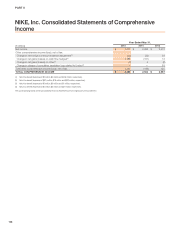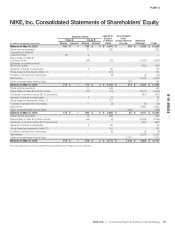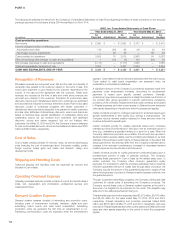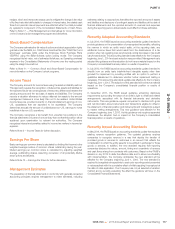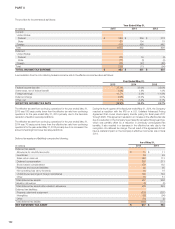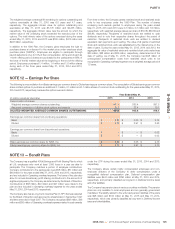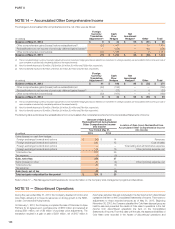Nike 2015 Annual Report Download - page 55
Download and view the complete annual report
Please find page 55 of the 2015 Nike annual report below. You can navigate through the pages in the report by either clicking on the pages listed below, or by using the keyword search tool below to find specific information within the annual report.PART II
the two-step impairment test is unnecessary. The two-step impairment test
first requires the Company to estimate the fair value of its reporting units. If the
carrying value of a reporting unit exceeds its fair value, the goodwill of that
reporting unit is potentially impaired and the Company proceeds to step two
of the impairment analysis. In step two of the analysis, the Company
measures and records an impairment loss equal to the excess of the carrying
value of the reporting unit’s goodwill over its implied fair value, if any.
The Company generally bases its measurement of the fair value of a reporting
unit on a blended analysis of the present value of future discounted cash flows
and the market valuation approach. The discounted cash flows model
indicates the fair value of the reporting unit based on the present value of the
cash flows that the Company expects the reporting unit to generate in the
future. The Company’s significant estimates in the discounted cash flows
model include: its weighted average cost of capital; long-term rate of growth
and profitability of the reporting unit’s business; and working capital effects.
The market valuation approach indicates the fair value of the business based
on a comparison of the reporting unit to comparable publicly traded
companies in similar lines of business. Significant estimates in the market
valuation approach model include identifying similar companies with
comparable business factors such as size, growth, profitability, risk and return
on investment and assessing comparable revenue and operating income
multiples in estimating the fair value of the reporting unit.
Indefinite-lived intangible assets primarily consist of acquired trade names and
trademarks. The Company may first perform a qualitative assessment to
determine whether it is more likely than not that an indefinite-lived intangible
asset is impaired. If, after assessing the totality of events and circumstances,
the Company determines that it is more likely than not that the indefinite-lived
intangible asset is not impaired, no quantitative fair value measurement is
necessary. If a quantitative fair value measurement calculation is required for
these intangible assets, the Company utilizes the relief-from-royalty method.
This method assumes that trade names and trademarks have value to the
extent that their owner is relieved of the obligation to pay royalties for the
benefits received from them. This method requires the Company to estimate
the future revenue for the related brands, the appropriate royalty rate and the
weighted average cost of capital.
Operating Leases
The Company leases retail store space, certain distribution and warehouse
facilities, office space and other non-real estate assets under operating
leases. Operating lease agreements may contain rent escalation clauses, rent
holidays or certain landlord incentives, including tenant improvement
allowances. Rent expense for non-cancelable operating leases with
scheduled rent increases or landlord incentives are recognized on a straight-
line basis over the lease term, beginning with the effective lease
commencement date, which is generally the date in which the Company
takes possession of or controls the physical use of the property. Certain
leases also provide for contingent rents, which are determined as a percent of
sales in excess of specified levels. A contingent rent liability is recognized
together with the corresponding rent expense when specified levels have
been achieved or when the Company determines that achieving the specified
levels during the period is probable.
Fair Value Measurements
The Company measures certain financial assets and liabilities at fair value on a
recurring basis, including derivatives and available-for-sale securities. Fair
value is the price the Company would receive to sell an asset or pay to transfer
a liability in an orderly transaction with a market participant at the
measurement date. The Company uses a three-level hierarchy established by
the Financial Accounting Standards Board (“FASB”) that prioritizes fair value
measurements based on the types of inputs used for the various valuation
techniques (market approach, income approach and cost approach).
The levels of hierarchy are described below:
•Level 1: Quoted prices in active markets for identical assets or liabilities.
•Level 2: Inputs other than quoted prices that are observable for the asset or
liability, either directly or indirectly; these include quoted prices for similar
assets or liabilities in active markets and quoted prices for identical or similar
assets or liabilities in markets that are not active.
•Level 3: Unobservable inputs for which there is little or no market data
available, which require the reporting entity to develop its own assumptions.
The Company’s assessment of the significance of a particular input to the fair
value measurement in its entirety requires judgment and considers factors
specific to the asset or liability. Financial assets and liabilities are classified in
their entirety based on the most conservative level of input that is significant to
the fair value measurement.
Pricing vendors are utilized for certain Level 1 and Level 2 investments. These
vendors either provide a quoted market price in an active market or use
observable inputs without applying significant adjustments in their pricing.
Observable inputs include broker quotes, interest rates and yield curves
observable at commonly quoted intervals, volatilities and credit risks. The fair
value of derivative contracts is determined using observable market inputs
such as the daily market foreign currency rates, forward pricing curves,
currency volatilities, currency correlations and interest rates and considers
nonperformance risk of the Company and that of its counterparties.
The Company’s fair value processes include controls that are designed to
ensure appropriate fair values are recorded. These controls include a
comparison of fair values to another independent pricing vendor.
Refer to Note 6 — Fair Value Measurements for additional information.
Foreign Currency Translation and Foreign
Currency Transactions
Adjustments resulting from translating foreign functional currency financial
statements into U.S. Dollars are included in the foreign currency translation
adjustment, a component of Accumulated other comprehensive income in
Total shareholders’ equity.
The Company’s global subsidiaries have various assets and liabilities,
primarily receivables and payables, which are denominated in currencies
other than their functional currency. These balance sheet items are subject to
re-measurement, the impact of which is recorded in Other (income) expense,
net, within the Consolidated Statements of Income.
Accounting for Derivatives and Hedging
Activities
The Company uses derivative financial instruments to reduce its exposure to
changes in foreign currency exchange rates and interest rates. All derivatives
are recorded at fair value on the Consolidated Balance Sheets and changes in
the fair value of derivative financial instruments are either recognized in
Accumulated other comprehensive income (a component of Total
shareholders’ equity), Long-term debt or Net income depending on the
nature of the underlying exposure, whether the derivative is formally
designated as a hedge and, if designated, the extent to which the hedge is
effective. The Company classifies the cash flows at settlement from
derivatives in the same category as the cash flows from the related hedged
items. For undesignated hedges and designated cash flow hedges, this is
primarily within the Cash provided by operations component of the
Consolidated Statements of Cash Flows. For designated net investment
hedges, this is within the Cash used by investing activities component of the
Consolidated Statement of Cash Flows. For the Company’s fair value
116




